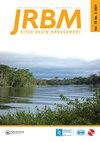绘制和分析洪水事件级联效应的方法学方法
IF 1.9
Q3 WATER RESOURCES
International Journal of River Basin Management
Pub Date : 2022-06-01
DOI:10.1080/15715124.2022.2079655
引用次数: 3
摘要
本文章由计算机程序翻译,如有差异,请以英文原文为准。
A methodological approach for mapping and analysing cascading effects of flooding events
ABSTRACT Current local or regional flood risk assessments, as required by the EU flood risk directive, rarely account for cascading effects due to interdependencies between critical infrastructures. However, it is essential to consider these effects, as they may severely impact areas outside the immediate flood risk area. The main purpose is to present and problematize a method (AB-CEM) for mapping and analysing cascading effects due to floods, aiming at also being relevant for other spatially widespread hazards. The method development and the pilot study, in Sweden, reveal that there is a prominent practical need for methods for mapping and analysing critical infrastructure interdependencies and cascading effects. Another key finding is that the method process and its results can serve as an important basis for decision-making about proactive and reactive efforts related to geographically extensive hazards. We further conclude that there is a recurring problem regarding sensitive and secret data. More specifically, the conflicting interests of information availability and information security concerning critical infrastructures, which needs to be resolved at the national level and communicated through clear guidelines. The method is a much-needed step towards accounting for cascading effects of floods in practice.
求助全文
通过发布文献求助,成功后即可免费获取论文全文。
去求助
来源期刊

International Journal of River Basin Management
WATER RESOURCES-
CiteScore
6.00
自引率
4.00%
发文量
48
期刊介绍:
include, but are not limited to new developments or applications in the following areas: AREAS OF INTEREST - integrated water resources management - watershed land use planning and management - spatial planning and management of floodplains - flood forecasting and flood risk management - drought forecasting and drought management - floodplain, river and estuarine restoration - climate change impact prediction and planning of remedial measures - management of mountain rivers - water quality management including non point source pollution - operation strategies for engineered river systems - maintenance strategies for river systems and for structures - project-affected-people and stakeholder participation - conservation of natural and cultural heritage
 求助内容:
求助内容: 应助结果提醒方式:
应助结果提醒方式:


